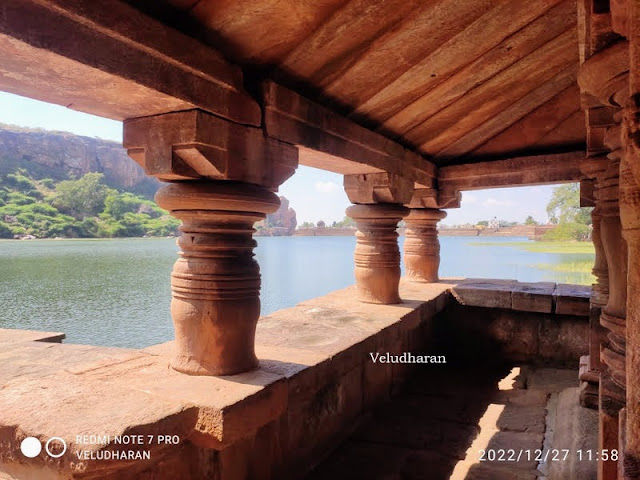The visit to this Bhutanatha Group of Temples at Badami was a part of “Hampi, Badami, Pattadakal, Mahakuta and Aihole temples Heritage visit” organized by வரலாறு விரும்பிகள் சங்கம் Varalaru Virumbigal Sangam – VVS and எண்திசை வரலாற்று மரபுநடைக்குழு, between 24th December to 28th December 2022. I extend my sincere thanks to the organizers Mrs Radha and Mrs Nithya Senthil Kumar and Mr Senthil Kumar.
Monuments at Badami
Badami, also known as Vatapi, was the capital of the Chalukyan empire ( 6th to 8th cent. CE.), which extended in the time of Pulikesin-II from Kanchi in Tamil Nadu to the banks of the Narmada and from Orissa to the west coast. After a set-back for a while owing to the attack of the Pallavas under Narasimha Varman-I, the Chalukyan kings regained their territory and gave impetus to the revival of Hindu religion and art under royal patronage Mahakuta, Aihole, Pattadakal and Badami became great centers of experimentation in temple building
Attracted by the scenic beauty and natural defences provided by the majestically standing hills and the vast sheet of water below. The Chalukyan kings shifted their early capital from Aihole to Badami. The remains of which can still be seen in the valley on the northern slopes. The natural gorge leading to the hill-city and embellished with temples and gateways is one of the major attractions of Badami apart from the famous rock-cut Brahmanical and Jaina caves which contain some of the finest sculptures known for their grace and vigour. The Chalukyan rulers built several structural temples along the edge of the lake and hill-tops which the visitor should not miss to see. Even while experimenting in temple building they evolved the proto type of the famous southern vimana style which the Malegitti Sivalaya. The lower Sivalaya and the upper Sivalaya represent.
The curve-linear sikhara of the Yellamma temple represents the northern style. While the Bhutanatha temples with stepped pyramidal roof represent the Kadamba-nagara type. Within a distance of 48 kms. More than one hundred and fifty temples were built by Chalukyan kings. The rock-cut temples-(caves - 1 to 4 are ornamented with exquisitely carved animal and human figures, gods and demi-gods. Floral and geometric patterns and scenes recalling the great episodes from the epics and puranas. Although the Chalukyans were Vaishnavites they encouraged construction of Jaina and Saiva temples also. After the fall of the Chalukyan empire the Rashtrakutas and Vijayanagar rulers and finally Tippu sultan occupied Badami the fort walls and other edifices built by them can also be seen here Badami abounds in a number of inscriptions, some of which are indispensable for writing the history of India. Among them mention may be made of the Pallava inscription on the boulder near the north gate and that of Mangalesha in cave 3. Here lived Prasanna Venkatadasa, a great Vaishnava saint of the 16th century CE, who used to meditate and sing devotional songs on a platform near the north-gate.
பூதநாதர் கோயில் தொகுப்பு
அகஸ்திய ஏரிக்கு அருகில் காணப்படுவதே பூதநாதர் கோயிலாகும். கிழக்கு பூதநாதர் கோயில்கள் பிரதான பூதநாதர் கோயில்கள் எனவும், வடக்கு பூதநாதர் கோயில்கள்/மல்லிகார்ஜுனர் கோயில்கள் என இங்குள்ள கோயில்களை இரண்டு வகைகளாக பிரித்துள்ளனர். இவை முறையே திராவிட மற்றும் நாகர கோயில் கட்டிடக்கலை கலைப்பாணியில் கட்டப்பட்டுள்ளது. பிரதான பூதநாதர் கோயில்கள் வாதாபி சாளுக்கியர் காலத்தில் 7-8ஆம் நூற்றாண்டிலும், வடக்கு பூதநாதர் கோயில்கள் கல்யாணி சாளுக்கியர் கலைப்பாணியில் 11-12ஆம் நூற்றாண்டுகளில் எடுக்கப்பட்டுள்ளது. பிரதான கோயில் சிவனுக்காக எடுக்கப்பட்டது. வடக்கு பூதநாதர் கோயில்கள் விஷ்ணுவிற்காக எடுக்கப்பட்டு, பிற்காலத்தில் சிவன் கோயிலாக மாற்றப்பட்டுள்ளது.
பூதநாதர் கோயிலுக்கு பின் புறம் உள்ள மலையின் பாறையில் நரசிம்ம அவதாரம், மகிஷனை வதம் செய்யும் தேவி, கணபதி, திரிமூர்த்திகளின் சிற்பம், வராக அவதாரம் போன்றவை புடைப்பு சிற்பங்களாக காணப்படுகின்றன.
Bhutanatha Temple, The Bhutanatha Group of Temples.
The Bhutanatha Group of Temples consists of Bhutanatha Temple and the Dasavatar Bas reliefs on a boulder and a Buddha Cave. This group has the main temple called “Sri Paigara Shridhara Bhuteshwara” in a record of the eighth century on the banks of Agasthya Lake. The temple has undergone repairs many times, and is a simple structure. An inscription in front speaks of "Kariyamma sthanada divige". is a Rashtrakuta temple to its north-east with Lakulisha image within and the image is assigned to the 7th or 8th Century CE. There are many shrines of Kalyana Chalukya times around this.
The main portion of this west-facing temple, comprising of a small square porch, a rectangular pillared hall and a square sanctuary was built in the first of 8th century CE, during the time of Chalukyas of Badami. It’s porch was enlarged in the 11th -12th centuries during the reign of Chalukyas of Kalyana. Its deity is Bhuthesvara, a form of Siva, represented as a Linga. Its sanctuary's elevation details are simple and consist of a basement with upana, jagati, tripatta-kumuda and prati mouldings, a wall with kudya-stambhas ( thin pillar-reliefs), kapota ( roll-cornice), hara (entablature, suggesting the end of ground storey ), super structure of storeys defined by haras, except the last, a griva ( neck ), a square sikhara (cupola) and a stupi (pot-finial). This makes it an excellent specimen of a dravidian temple. The differences between the early and later chalukyan pillars can be noticed in the large open porch entered from the sides and front. The added part has a kakshasana or peripheral back.
HOW TO REACH
The Bhutanatha Group of temples is about 2 KM from Badami Bus Stand and autos are available from the base of the caves also.
The Bhutanatha Temple is about 22 KM from Pattadakal, 36 KM from Aihole and 453 KM from Bengaluru.
Nearest Railway station is Badami, about 7 KM.
LOCATION OF THE TEMPLE : CLICK HERE
---OM SHIVAYA NAMA ---
































No comments:
Post a Comment